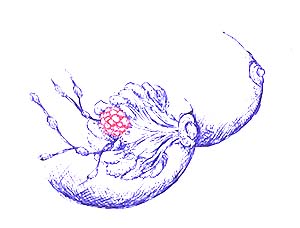The Reality of Breast Cancer
Breast cancer occurs when breast cells grow uncontrollably. “Breast cancer” refers to a harmful tumour developed from cells in the breast. It is the most common type of cancer among women in Malaysia. An average of 4,000 new cases are reported each year in Malaysia, where 1 in 9 women is diagnosed with breast cancer.

About the breast
A woman‘s breast is made of fatty tissues that could produce milk. There are 15 to 20 sections within the breast called lobes. A smaller structure exists within each lobe, known as lobules. Lobules produce milk which travels through ducts that are made up of a network of tubes. The breast also consists of connective tissues, blood vessels, ligaments, lymph vessels and lymph nodes. The size of the breast is determined by the amount of fat in it.
Common Types of Breast Cancer
Ductal Carcinoma In Situ (DCIS)
Also known as intraductal carcinoma, it is a non-invasive breast cancer. Some cells in the lining of the ducts of the breast tissue have started to turn into cancer cells. As they are contained inside the ducts, they have yet to spread to the surrounding breast tissue.
Lobular Carcinoma In Situ (LCIS)
Also called lobular neoplasia, this condition is not a form of cancer, but abnormal cells found within the inner lining breast lobules which are glands that produce milk when breastfeeding. The abnormal cells are all contained within the inner lining of the breast lobules. However, it can increase the risk of getting breast cancer.
Invasive or Infiltrating Ductal Carcinoma (IDC)
One of the most common types of breast cancer, IDC begins in the milk duct of the breast, eventually penetrates the wall of the duct, and develops in the fatty tissue of the breast.
Invasive or Infiltrating Lobular Carcinoma (ILC)
ILC begins in the lobules, the milk-producing glands and it may spread to other parts of the body.
Staging and Grading
Once you have been diagnosed positive for cancer after a biopsy test, the condition will be given a stage and grade. This vital information will help you and your healthcare team to choose the best treatment for you. The cancer stage will describe the size of the tumour and how far it has spread.
There are 5 stages for breast cancer
Stage 0:
- Non-invasive breast cancers, such as DCIS (ductal carcinoma in situ)
- No evidence of cancer cells or non-cancerous abnormal cells breaking out from the original site in the breast, or getting through to surrounding normal tissues
Stage 1:
- Tumour measures up to 2cm
- The cancer has not spread to outside the breast, which means no lymph nodes are involved
Stage 2:
- Tumour measures between 2 to 5cm
- The cancer has spread to the lymph nodes under the arm on the same side as the breast cancer
Stage 3:
- The tumour in the breast is more than two inches in diameter across
- The cancer is extensive in the underarm lymph nodes, or has spread to other lymph nodes or tissues near the breast
Stage 4:
- Invasive breast cancer has spread past the breast and nearby lymph nodes, reaching other organs of the body
- “Advanced” and “Metastatic” are used to describe stage IV breast cancer
There are 3 grades of invasive breast cancer:
- Grade 1 (well differentiated) – The cancer cells look mostly like normal cells and are usually slow-growing
- Grade 2 (moderately differentiated) – The cancer cells look less like normal cells and are growing faster
- Grade 3 (poorly differentiated) – The cancer cells look most changed and are usually fast-growing
WARNING SIGNS
- Swelling of all or parts of the breast
- Skin irritation or dimpling
- Breast pain
- Pain in the nipple or nipple turns inwards
- Redness, flakiness , or thickening of the nipple skin or breast skin
- A nipple discharge that’s not breast milk
- A lump in the underarm area
AM I AT RISK?
Yes, if you fit the following:
- Consume unhealthy food uncontrollably
- Smoking
- Drinking alcohol
- Being overweight
- Never breastfed
- Had no children
THERE ARE RISK FACTORS THAT CAN'T BE CHANGED
- Being a woman
- Getting older
- Inherited cancerous genes
- Family history of breast cancer
- Race and ethnicity
- Denser breast tissues
WHAT CAN I DO?
Beat the cancer. Cut your risk by taking these steps:
- Add healthy choices to your diet
- Exercise
- Quit smoking habit
- Limit drinking alcoholic drinks
I have a higher risk of getting breast cancer. Can it still be prevented?
There is no definite way to avoid breast cancer, but you can take preventive measures to further lower the risk:
- Medication to reduce breast cancer risk
- Preventive surgery
Breast Cancer Myths Vs Facts
Myth |
Fact |
| Chemicals from antiperspirants are absorbed by the body through the skin, blocking the release of toxins when you sweat. Eventually, it will cause these toxins to build up in the breast. | Antiperspirants don’t block all perspiration in the armpit, even the strongest ones. The kidneys are the ones that remove most cancer-causing substances, either releasing them through urine or processed by the liver. |
| Underwire bras can cause breast cancer as it blocks the drainage of lymph fluid at the bottom of the breast. Hence, toxins cannot be flushed out. | Underwire bras do not cause breast cancer. There is no scientific evidence to support these myths. |
Source: www.breastcancer.org. American Cancer Society



